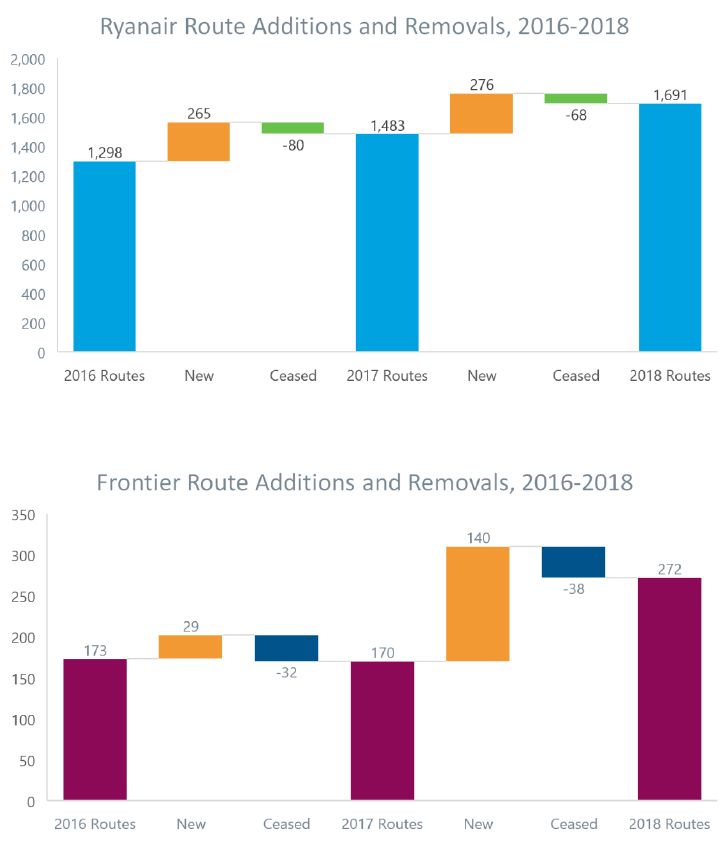How low-cost carrier route volatility can help airports not just survive, but thrive
Airports should prepare for the high route-volatility of low-cost carriers with a new approach.
New route launches, frequency increases, and capacity up-gauges…airlines must be amid a renaissance, spurred by none other than low-cost carriers (LCCs) and ultra-low-cost carriers (ULCCs)—right?
Since reporting that routes are ceasing or downgrading can paint a negative picture for an airline or airport, the casual observer may believe that we are experiencing an era of unprecedented new route additions.
In fact, while it is certainly true that each season brings several new services, a meaningful proportion of them will not survive their inaugural year.
Legacy carriers have always operated with relatively low levels of route volatility within their networks, reflecting a relatively stable network – often one strong hub base and typically a more mature overall rate of growth. This contrasts sharply with LCCs that must find ways to make new routes work, reflecting their rapid expansion and market stimulation on many new routes.
The question for airports is how do they not just survive the LCC volatility—but thrive?
ASD 2.0 can drive airport success
Airports can’t do much to make themselves more strategic to airlines, but they can take steps to improve expected short-term risk-adjusted return.
To minimise the chance that your airport’s services get cut in the inevitable annual volatility, use industry data, not necessarily to persuade airlines to add service but instead to understand how airlines view their market. Is current service sufficiently profitable that they can reasonably expect new service to be profitable as well -- not only in absolute terms, but relative to other opportunities they might be considering? If not, what is the size of the gap?
Next, airports should take steps to narrow any gaps the airlines perceive, typically by increasing demand from airline target passengers. Depending on the airport, this can mean:
- In-market demand generation
- Destination demand generation
- Connecting demand generation
- Lowering entry barriers
LCC success is built on ‘failure’
Two good examples of LCC volatility are Ryanair in Europe and Frontier in the United States. Today, Ryanair operates 1,700 routes across Europe with plans for additional 275 in 2018. For comparison, British Airways has a total of 268 routes in its entire network. This follows the 2017 trend, taking the total number of new routes added over two years to more than 500.
We hear much less about the 70 or so routes that are "lost" each year. This is either a case of established routes underperforming or a quick response to recently added routes that have not met expectations. In summer 2018, Ryanair is due to cease nearly 70 routes representing 5% of its network. Of these, 18 were introduced just one year previously (e.g., Brussels – Hamburg). This is a fairly typical approach to LCC network development that still results in significant net network growth. It’s quite different from the long lead times and withdrawal times of full service carriers that are typically more concerned with market presence, investments in a market, and hub dynamics.
An LCC has much less to lose by exiting an un-competed point-to-point market. Without this "try it and see" approach, far fewer sustainable routes would be uncovered as they would never pass the thresholds of traditional network planning.

Frontier has an even higher proportion of volatility across their network than Ryanair, cutting 30-40 routes annually. Although this is offset by new route additions, it still represents approximately 20% of their routes ceasing each year being cut or moved to new markets in support of the carrier’s growth ambitions. Chart source = SRS Schedules July (each year)
How LCCs will drive growth
Recent fleet orders are a clear indicator that LCCs will continue to drive market growth, especially in Europe, where 90% of seat growth is driven by this market segment. LCCs are forecast to add more than 10% additional seating to the market, compared to just 1% from the legacy carriers. In the U.S., LCCs like Spirit, Frontier, and Allegiant are growing at a combined rate of 15%—nearly four times the market average.
As these airlines become increasingly mainstream and add more capacity than legacy airlines, airports need to understand this different approach to network development. A more tailored approach to air service development (ASD) is often required for carriers seeking to expand in new, and often previously untested, markets.
Whatever approach is right for your airport, consistent, regular communication with airlines is essential. The aim is not so much to persuade them, but to inform them, seek their feedback, and look for ways to make your plan more relevant and meaningful for them. This step alone will differentiate an airport from most of its competitors, whose focus is on trying to tell airlines how to plan their networks.